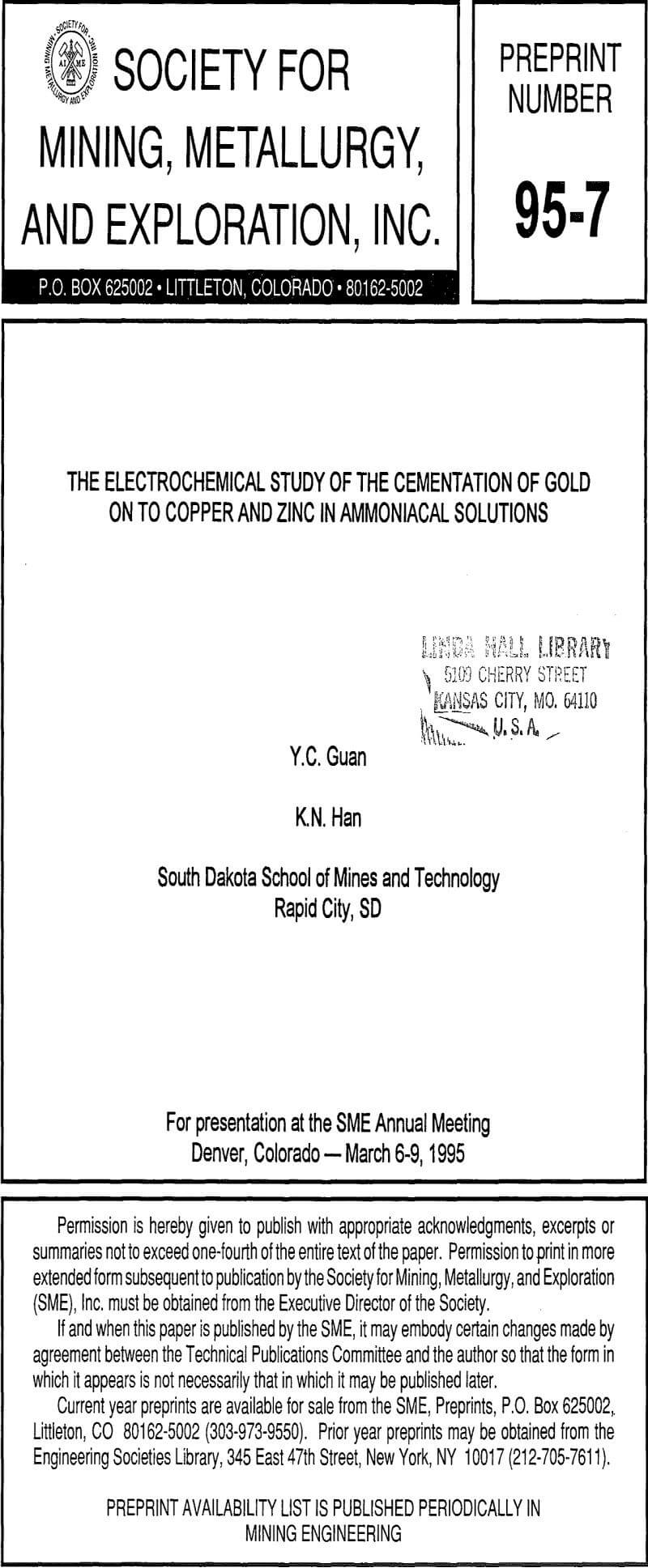The cementation of gold on to copper and zinc in ammoniacal solutions has been investigated using electrochemical techniques and conventional cementation experiments:
- Studies of cathodic reduction of Au(NH3)2+ have shown that the cathodic reaction can be expressed as:
Au(NH3)2+ + e = Au + 2NH3
and the standard reduction potential, E°, has been estimated to be 0.330 V. The stability constant of Au(NH3)2+ has been found to be 10 18.52. The cathodic current density increased with the increase of the overpotential, then the limiting current density was reached. The limiting current density which was proportional to the aurous ammine concentration and to the square root of the disc rotation speed, was not affected by the pH of the solution. - The anodic dissolution of copper and that of zinc in ammoniacal solutions revealed that the anodic current density increased with the increase of the applied potential initially, and then a limiting current density plateau was formed. The limiting current density increased with the increase of the disc rotating speed. The anodic reactions can be expressed as:
Cu + 2NH3 = Zn(NH3)2+ + e
Zn + 4NH3 = Zn(NH3)4++ + 2e - The Combination of the anodic and cathodic polarization curves showed that the intersection points were located in the diffusion-limiting region on cathodic curves and in the activation region on the anodic curves. The cementation reaction was considered to be controlled by the mass transfer of Au(NH3)2+ to the reaction surface under the experimental conditions. The cementation reactions can be expressed as:
Au(NH3)2+ + Cu = Au + Cu(NH3)2+
2Au(NH3)2+ + Zn = 2Au + Zn(NH3)4++ - The gold deposited on copper was coherent, smooth and shining. On the other hand, the gold could not stick on zinc due to the dissolution of zinc in the deaerated ammoniacal solutions.
- The cementation rates were not affected by the ammonia concentration, but a sufficient amount of ammonia was necessary in the process. The cementation rates increased with the increase of gold ammine concentration and followed a first order. They increased with the increase of the disc rotating speed, and it was directly proportional to the square root of the disc rotating speed. It indicates that the rate was controlled by mass transfer of Au(NH3)2+ to the reaction surface under the experimental conditions.

The gold disc used for cathodic reduction of Au(NH3)2+ was made from a sheet of 99.9% gold metal. The copper and zinc discs used for the anodic dissolution and the cementation of gold were made from 99.9% of these metal plates. The dimensions of the discs were 24.13 mm in diameter and 1 mm in thickness. Disc holders were made of Teflon and ensured to provide extra frame to avoid the edge effect. The disc was mounted in a holder with the aid of Dure Super Glue.
Electrolytes with various gold concentrations were prepared by dissolving known amounts of analytical grade AuCN in 0.5 M ammonium sulfate solutions at pH 9.8. When the effect of pH was studied, the pH of the solution was adjusted by changing the ratio of NH3 to NH4+, but the total ammonia concentration was kept constant at 1.0 M. The pH of the solution was measured before and after the experiment. Sodium sulfate was used as a supporting electrolyte to compensate the ionic strength of the solutions.
The cementation experimental set up can be found in the pervious work. Samples of solution were withdrawn at regular time intervals for chemical analysis. All chemical analyses were carried out using a Perkin Elmer atomic absorption spectrometer, Model 5500.
Unless otherwise mentioned, the general experimental conditions used were: temperature, 296 K; total ammonia concentration, 1.0 M; disc rotating speed, 62.8 rad/sec (600 r.p.m.); the ionic strength of the solution, 1.5 (using sodium sulfate for compensation); pH 9.8; scan rate, 1.0 mV/sec.
Cementation experiments were conducted on a copper and a zinc rotating disc in ammoniacal solutions with aurous ammine. Figure 7 shows the cementation behavior of gold on to a copper rotating disc at various rotation speeds. Log (rate) versus log (rad/sec) was plotted in Figure 8. According to Levich (1962), if the cementation rate is mass- transfer controlled, it should be directly proportional to the square root of the disc rotating speed. The slope of the line in Figure 8 was calculated to be about 0.48 ± 0.02. The study on the effect of aurous ammine showed that the cementation rate was a first order with respect to the concentration of aurous ammine. The results suggest that under the experimental conditions studied, the cementation rate of gold on to copper in ammoniacal solutions is consistent what is expected for a mass-transfer controlling system. This conclusion is in line with that drawn from the mixed potential theory prediction. The stoichiometric relationship between gold and copper was determined to be about 1 to 1 by analyzing the concentrations of gold and copper in the bulk solution.
